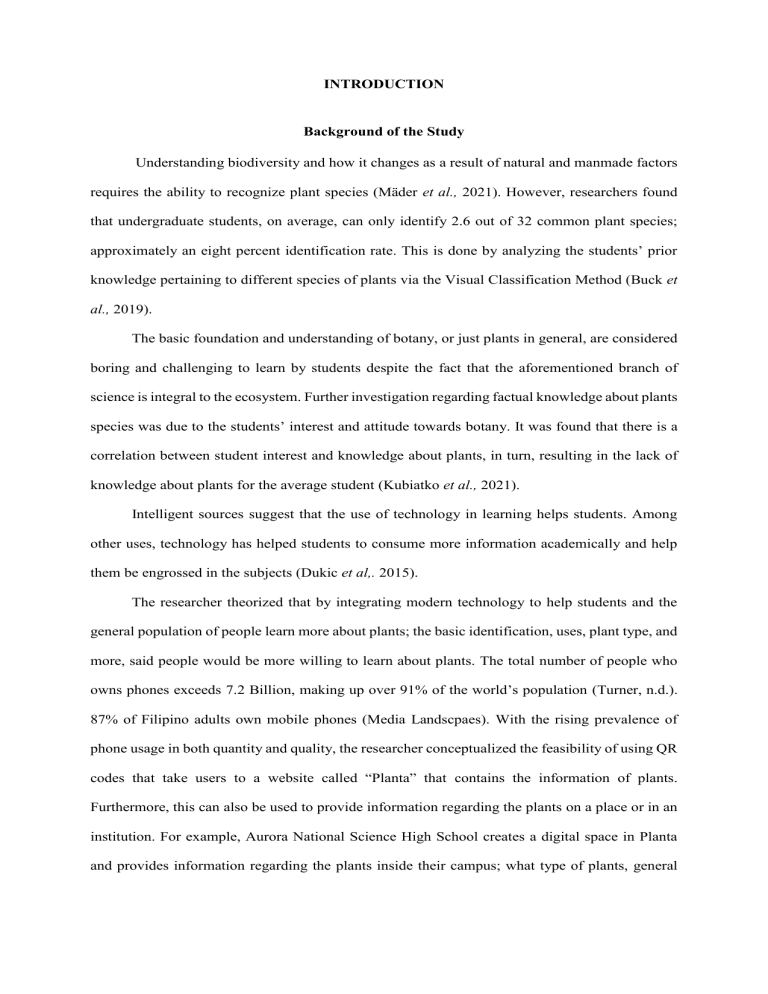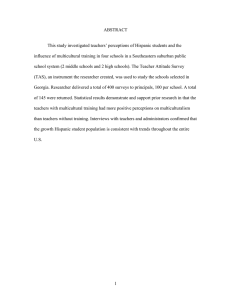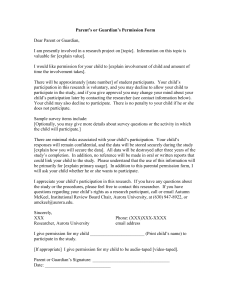
INTRODUCTION Background of the Study Understanding biodiversity and how it changes as a result of natural and manmade factors requires the ability to recognize plant species (Mäder et al., 2021). However, researchers found that undergraduate students, on average, can only identify 2.6 out of 32 common plant species; approximately an eight percent identification rate. This is done by analyzing the students’ prior knowledge pertaining to different species of plants via the Visual Classification Method (Buck et al., 2019). The basic foundation and understanding of botany, or just plants in general, are considered boring and challenging to learn by students despite the fact that the aforementioned branch of science is integral to the ecosystem. Further investigation regarding factual knowledge about plants species was due to the students’ interest and attitude towards botany. It was found that there is a correlation between student interest and knowledge about plants, in turn, resulting in the lack of knowledge about plants for the average student (Kubiatko et al., 2021). Intelligent sources suggest that the use of technology in learning helps students. Among other uses, technology has helped students to consume more information academically and help them be engrossed in the subjects (Dukic et al,. 2015). The researcher theorized that by integrating modern technology to help students and the general population of people learn more about plants; the basic identification, uses, plant type, and more, said people would be more willing to learn about plants. The total number of people who owns phones exceeds 7.2 Billion, making up over 91% of the world’s population (Turner, n.d.). 87% of Filipino adults own mobile phones (Media Landscpaes). With the rising prevalence of phone usage in both quantity and quality, the researcher conceptualized the feasibility of using QR codes that take users to a website called “Planta” that contains the information of plants. Furthermore, this can also be used to provide information regarding the plants on a place or in an institution. For example, Aurora National Science High School creates a digital space in Planta and provides information regarding the plants inside their campus; what type of plants, general information, the quantity of each plant type, the taxonomy of each plant, and a map of the campus showing where these plants can be located. Objective of the Study The general objective of the study is to create a website containing information on plant species that can be tracked through QR codes. Specifically, this study aims to: 1. make it easier to access plant information by providing physical QR codes next to plants; 2. allow people and institutions to have their own digital space where they can provide information about their plants; and 3. further expand the integration of modern technology in education. Significance of the Study Innovations in education have been made possible by technological advancements. Traditional education is thriving thanks to new technologies and more learner-centered environments. There are learners that prefer self-learning on this spectrum. Traditional learning materials have been upgraded to be more appealing, motivational, and technologically advanced. One of these inventions is the QR (Quick Response) Code (Durak et al., 2016). Citizen science, environmentalism, and education may all benefit from the use of mobile applications (Mäder et al., 2021). This study aims to integrate the quick response code technology into education, allowing user-friendly interactions between the learner and the environment. By giving each plant a QR code, mobile users can scan it and be sent to a website or app containing the general information of the plant type, or the plant itself if it contains significant history such as the Tree That Owns Itself in Athens, United States. Scope and Limitation of the Study The study aims to create an app/website that would give information about plant species and historical plants all over the world which would be trackable with Quick Response (QR) Codes. However, the study will be limited to the website of plants inside the campus of Aurora National Science High School in creating the prototype. This will include the plant types, the general information of each plant type, and the plant location shown via Google Maps. The respondents of the study will answer a survey limited to three parts; demographic profile; student perceptions towards the use of QR Codes in education; and perceptions towards planta. Time and Place of the Study The study was conducted in Brgy. Zabali, Baler, Aurora, Philippines from April to May 2022. REVIEW OF RELATED LITERATURE The Use of Quick Response (QR) Codes in Education QR codes have been around for years, thanks to a Japanese company. With the introduction of smart and Web-enabled mobile devices, we've seen a steady increase in the number of fascinating commercial QR code applications (Law and So, 2010). This has been used for the mobile-learning method that incorporates quick response codes. It achieved significant results in favor of outdoor education, but also found that it increases the uses of the Cognitive Theory of Multimedia Learning (Lia et al., 2013). Learners reported their awareness of quick response codes; how it is used; and how useful it is in education. They have also expressed the positive impact of implementing QR codes in education due to visual elements, direct routing, and attractiveness. No reports of difficulty were given (Durka et al., 2016). Existing Plant Identification Apps A plant identification app called Flora Incognita allows uses user action for the process of identification. Users take multiple images of a plant from different angles and the app will identify the unknown plant. It also makes use of geolocation, given the user’s consent, to identify the habitat of the plants which would help the identification process. Flora Incognita is a client-server system that consists of scalable microservices running in our data center and client apps that make the identification service available in a variety of circumstances. The server side is divided into three parts: an observation service, an identification service, and a training service. An intuitive UI and additional instructional materials are available to users. The observations, along with their information, constitute a valuable resource for studying, monitoring, and understanding plant variety (Mäder et al., 2021). MATERIALS AND METHODS Research Methods and Techniques The Sample 100 people were chosen to participate in the study. Samples are selected randomly online and in-person. However, the number of respondents where only 50. The Instruments The researcher used the following techniques in gathering data. Survey questionnaire. The instrument used for data analysis a questionnaire given to the respondents through google forms and physical questionnaires. Internet research. The researcher conducted this instrument to gather more data and topics relevant to the study. It gives the researcher an idea for the topics they used. Library research. The researcher also used existing literature such as thesis papers and books related to the study in gathering information. Data Collection Procedure The researcher reached out to numerous people online. The researcher chose participants at random and gave them either the google form or physical copy of the questionnaire. The demographic profile of the respondents is presented in percentages. To present the respondents’ score in each question, the weighted mean shall be used to interpret the data. Perceptions Toward the General Use of QR Codes in Education Scale 4 3 2 1 Range 3.26-4.00 2.51-3.25 1.76-250 1.00-1.75 Verbal Interpretation Strongly Agree Agree Disagree Strongly Disagree Perceptions Toward Plant: Plant Information Website Trackable via QR Codes Scale Range Verbal Interpretation 4 3 2 1 3.26-4.00 2.51-3.25 1.76-250 1.00-1.75 Strongly Agree Agree Disagree Strongly Disagree Physical Quick Response Codes Preparation of Physical QR Codes Quick Response (QR) codes will be designed in Adobe Photoshop and printed in paper. The paper containing the QR Code will be laminated for a tougher exterior, protect the paper, and prevent the ink from deteriorating. Figure 1.1 Design of QR Code Paper Figure 1.2 Physical Copies of QR Codes Display of Quick Response Codes Quick Response (QR) Codes will be displayed near a plant that it provides the information of. The laminated paper containing the QR code will be tied to a piece of rope around the tree. Figure 2. Display of QR Code Development of Prototype: Planta Website Demo Figure 3. (3.1) Home Page, (3.2) Places and Institution Page, (3.3) ANSHS Page Platform The website: Planta, will be developed using the online platform Wordpress. Wordpress allows the researcher advantages compared to traditional HTML website development such as consumed time by learning the language and development of the demo website. Extra Tools Google Maps is integrated into the website to show the location of the plants via the Geographic Coordinate System. The researcher made custom locations of trees in the interactive map. Clicking the location will provide an image of the specific tree on the specific location, while also providing its coordinates. Figure 4. (4.1) Embedded HTML of Custom Google Maps in Planta, (4.2) Tree Location Info Pages and Posts The demo website of planta contains three pages: The Home Page: Places and Institutions: and Aurora National Science High School in order. The third page; Aurora National Science High School contains the hyperlinks that takes the user to posts of specific plant types which contains basic information, taxonomy, and location. While these posts can be visited via search engines, these posts will typically be visited using QR codes. Figure 4.1 Post of Indian Mango Figure 4.2 Post of Indian Mango (Labeled) Data Gathered Significant data were gathered, evaluated, and recorded in a spreadsheet. Details in the study will be presented chronologically. Survey Questionnaire: 1. Perceptions Towards the General Use of QR Codes in Education a. QR Codes should be more prevalent in education. b. QR Codes help both students and teachers in education. c. QR Codes allows studens to be more engrossed in education. 2. Perceptions Towards Planta: Plant Information Website Trackable Via QR Codes a. I think being able to track plant information via QR Codes is useful and convenient for educational purposes. b. I think being able to track plant information via QR Codes is useful and convenient for tourism. c. I think institutions and places having their own space in the internet for plant information is useful for education. d. I think institutions and places having their own space in the internet for plant information is useful for tourism. e. I think being able to track the location of specific plants in the website is useful. f. I prefer prominently being displayed simple, easy to understand information over advanced information. g. Planta will be helpful for students. h. Planta will be helpful for tourists. i. Planta will be helpful for the general population. Website Performance 1. Do QR Codes direct the user to the right plant in the right place? 2. Does the website and all its pages run properly?




